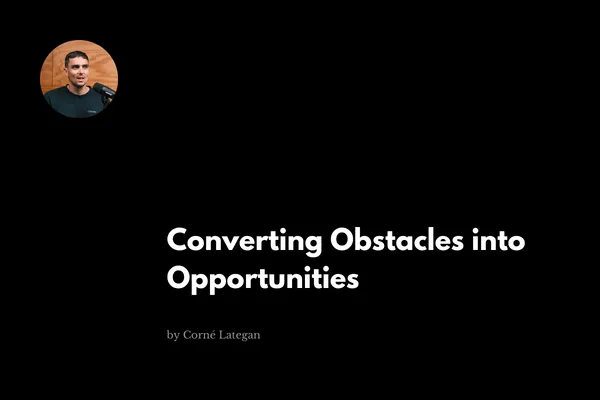Corné Lategan

Converting Obstacles into Opportunities
We all experience problems. It’s a daily thing.
I will be working. Then, one of my team members will knock on my office door. They will deliver bad news about a client with a problem. At first, my heart rate rises and I get flustered – it hurts.
For most of my life, I struggled to see the opportunity in problems.
I love creating new things—new products and new systems. Sometimes, I sit at a coffee shop sipping an Almond Latte. I'm brainstorming and thinking, "What is a new product idea?" Instead of brainstorming for something unique, I should observe the pain.
Building a business on a Foundation of Problems
We have built our business on a foundation of problems. This is an unusual way to think about it.
Because, as humans, we want to avoid problems. I’m no different; at first, I want to do everything I can to avoid it or even forget about it. But now, the problem has opened a loop. And until we close the loop, I won’t stop thinking about it.
The open loop takes me and my team on a quest to solve the problem.
All I want is to fix the problem at face value. Sometimes, we do this, but then the problem reoccurs. It’s because we didn’t drill deep enough to solve the underlying problem—the root cause. I'll tell you about an exercise to help this in a second.
Pain allows you to identify your weaknesses. If you can turn the weakness into a strength, you will become unstoppable.
The problem with seeing problems as bad is this: you'll get stuck in a cycle of negativity and won’t enjoy them.
We don’t like pain. We see it as a bad thing. Something to avoid at all costs.
Pain is a Signal
It’s like touching a hot stovetop. It will be painful. It will teach you not to touch it again. This doesn't mean you should avoid the hot stovetop or remove it from your kitchen. Having a hot stove top is an opportunity to cook food.
When we understand that “pain is a signal”, it will transform the way we solve problems. It changes our approach from defence to offence.
Your problem can turn into a solution that produces asymmetrical results. When you find a solution to a problem that adds value, you can apply it to more people with the same problem. This is value. This is your new product.
Use The 5 Whys exercise to find the solution
When you experience a problem, stop and use this exercise. Find the root cause, then make a solution to fix it.
The 5 Whys exercise:
Identify problem - Let’s say it’s a client that’s not happy with your delivery time.
Ask why? - You lost track & forgot.
Why? Trying to deliver on many clients yourself all at once.
Why? Don’t have a system in place to keep track of and plan your projects for the week.
Why? - You never took the time out to build a system and a process.
Why? - You have always focused on other areas of the business.
Solution? Take time out. Build a system to keep track of all clients. It will also make the client experience better.
The FS blog explains this in more detail and I’d suggest reading the article.
Instead of using a bandaid to fix the surface problem, use The 5 Whys exercise. It gets to the root cause where you can fix the underlying problem.
Fix the problem. Then, you might have found a valuable solution the market wants.
I hope this letter helps you find opportunities.
Corné

Instagram
X
Youtube